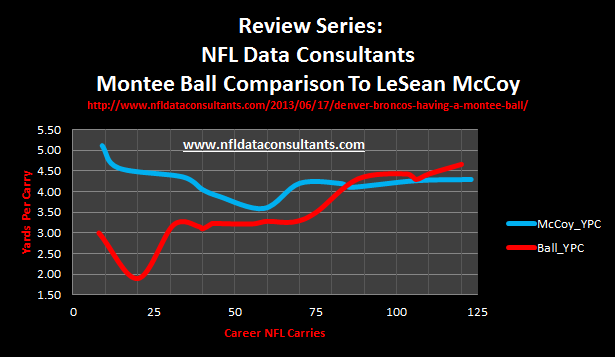When NFL Data Consultants used a comparison of Montee Ball to LeSean McCoy in the opening of a series of projections last summer, it was done for three purposes.
- It was to highlight the power of analytics and forecasting of personnel in a billion dollar industry. Rookie deals are the best salary cap bargains so why not devote resources to player forecasts as an additional decision tool?
- It was to compare to others using an analytical approach. Montee Ball was heavily attacked on other analytical players. He was repeatedly stated to be too slow or just another Wisconsion RB. With NFL Data Consulants rules/methodology/metrics, these were able to be dispelled. Montee Ball had 50 less carries than Gio Bernard and had just as many 20+ yard runs and 1 more 40+ yard runs. Montee Ball had an amazing 29.2% of his carries go for a first down. That was better than Eddie Lacy, Le’Veon Bell, Zac Stacy, Giovanni Bernard, and Andre Ellington. The objective of the game is to win and moving the chains is critical.
- It was also put out there to be graded and reviewed because we name this project “The Win Project”. That is why NFL Data Consultants measures and compares and grades ourselves. It is just the tip of the iceberg of the ideas that NFL Data Consultants has in store for an organization that fully embraces this approach and is willing to commit to a team to carry the more advanced ideas out.
Graphed below is first 120 carries of Montee Ball compared to the first 123 carries of LeSean McCoy. This does not factor in age, but Montee Ball’s 2nd half jump correlates with the jump that LeSean McCoy saw in his 2nd year. Montee Ball is a little older than what LeSean McCoy was during his rookie season. McCoy averaged 4.11 ypc as a rookie, and then it jumped to 5.22 yards per carry in his second season. After his first 120 attempts, McCoy topped out at career average of 4.98 ypc at just past 525 carries at 23.33 years old. McCoy’s surge began near 140 carries in and continued until around that 525 mark. Montee Ball’s last regular season game was at 23.07 years old and he sits at 4.66 and averaged over 6 yards per carry over his last 6 regular season games. Montee Ball is still trending up after a slower start, but was clearly the better runner in the Denver Broncos backfield. Knowshon Moreno averaged 4.31 ypc and had only a 22% first down percentage.
If you are an organization seeking to draft a RB, this type of projection analysis can work as a tool for your decision makers. NFL Data Consultants uses enough metrics to fill an NCAA tournament bracket for RBs.
If you are an organization considering an early round Quarterback, this article on the odds of selecting a franchise Quarterback is worth the quick read.
